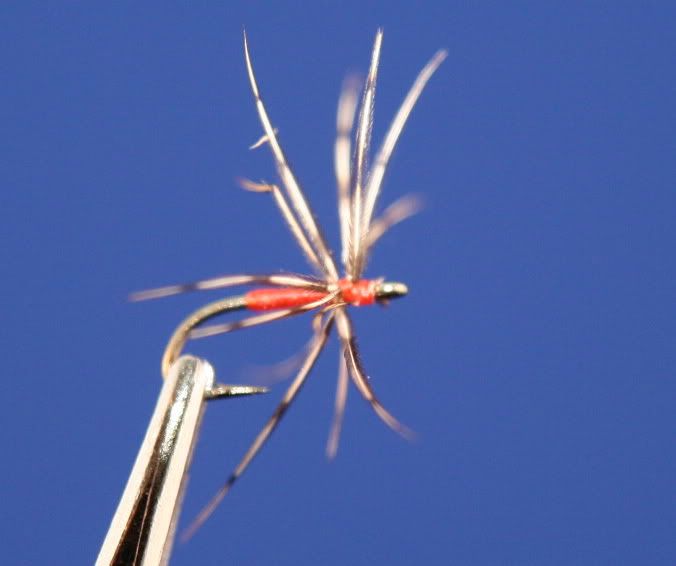Page 1 of 1
Problem
Posted: Fri May 28, 2010 4:49 pm
by fflutterffly
I deal with Trico that are facilitated by very small flies: 20/22/24. My problem is feathers. How do I find feathers that are small enough for these sizes. I have full pheasant bodies in the drawer with no tiny feathers! What bird can I use?
Re: Problem
Posted: Fri May 28, 2010 5:12 pm
by letumgo
Starling hackle works nicely for very small patterns...
Re: Problem
Posted: Fri May 28, 2010 5:28 pm
by Old Hat
I use starling or neck feathers from quail for small trico and midge patterns.
Here is some starling on a #21 Tiemco hook midge pattern.

Any smaller than that and you can use dubbing in a twisted thread. This is a smaller pattern #22 midge and I used mole dyed blue in a twisted thread for the hackle.

Re: Problem
Posted: Sat May 29, 2010 7:36 am
by tie2fish
I've seen Whiting 100's in sizes smaller than #20. You might check with Jim Slattery about that.
Re: Problem
Posted: Sat May 29, 2010 9:30 am
by flyfishwithme
fflutterffly wrote:I deal with Trico that are facilitated by very small flies: 20/22/24. My problem is feathers. How do I find feathers that are small enough for these sizes. I have full pheasant bodies in the drawer with no tiny feathers! What bird can I use?
Having said that, there are very small feathers on the Pheasant skins that you could consider. Remember that, generally speaking, you are looking for feathers that are 1.5 to 2 times the length of the hook. For example this is a size 20 hook:

and I do have some down to 24.
Now Pritt would say to reduce the dressing on a larger hook rather than use a small hook. IT the hook is fine enough it will work.
Cheers
Re: Problem
Posted: Sat May 29, 2010 9:42 am
by Old Hat
I would have to agree with Pritt on that matter. I rarely tie on anything smaller than a #16, a select few #18. I often tie on #12 and #14 hooks but keep the pattern sizes #14 and #16 respectively. I went this route a number of years ago and haven't noticed any catch difference. Now there are those select catch-and-release spring creeks here in the Pacific Northwest where it is necessary to go with the very small fly on the small hook but I think you can get away with the small pattern on a larger hook in most cases.
Re: Problem
Posted: Sat May 29, 2010 5:20 pm
by fflutterffly
As always the information is taken to heart. My thinking with tying with a larger hook, while tying the actual fly small is the weight of the hook. I'm worried that the fly will be pulled under. You guys know how these little Trico's form a ball, a little cluster. That's what I'm looking for. I like all your ideas and I think I've been tying the feathers to short.
Thanks again.
Re: Problem
Posted: Sat May 29, 2010 8:32 pm
by RnF
You could use longer feathers if you use the technique shown in this video. This video uses a synthetic, but I use it often with feathers.
http://www.youtube.com/watch?v=Zmgebw1Wo5s
There is also a v-notch tie in technique that I like to use shown with the following link
http://www.charliesflyboxinc.com/flybox ... rentID=155
Re: Problem
Posted: Sat May 29, 2010 8:49 pm
by Old Hat
If you're after a cluster dry then I don't think you can beat a Griffith's Gnat. Clip the bottom short if you want it to ride lower. I use Whiting 100 packs for these. I was under the assumption you were after a wet fly.
Re: Problem
Posted: Mon May 31, 2010 1:01 pm
by skunkaroo
fflutterffly wrote:I deal with Trico that are facilitated by very small flies: 20/22/24. My problem is feathers. How do I find feathers that are small enough for these sizes. I have full pheasant bodies in the drawer with no tiny feathers! What bird can I use?
Many good quality genetic hen
capes will have feathers suitable for tying in those sizes. The trick is looking at them in hand to pick out the best one suited for the job--easy in the shop, but less so on-line.
The alternatives listed above are all good. I would definitely look at smaller partridge neck feathers as well.
Aaron


